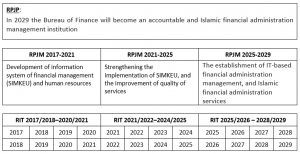The Development of the Bureau of Finance of Universitas Muhammadiyah Surakarta
The Bureau of Finance is one of the supporting units for the conduction of higher education at Universitas Muhammadiyah Surakarta, under the coordination of the Vice Rector II. Broadly speaking, the Bureau of Finance plays a role to manage the financial administration starting from receiving student payments, verifying budget submissions, disbursing budgets, receiving and checking budget use reports, and making financial reports.

As a supporting unit/institution, the Bureau of Finance has a vision and mission that is in line with the vision and mission of Universitas Muhammadiyah Surakarta. The complete formulation of the vision, mission, and objectives of the Bureau of Finance is as follows:
Vision:
In 2029, the Bureau of Finance of Universitas Muhammadiyah Surakarta is targeted to become an accountable and islamic financial administration management institution, which supports the establishment of the vision of Universitas Muhammadiyah Surakarta as a center for education and development of islamic science and technology and provides a direction for community change.
Mission:
- Profesional in service and providing financial information,
- Utilization of modern technology in the financial management,
- Implementation of islamic values in the service and financial management.
Objectives:
- Creating the competent financial management staff in accordance with their fields,
- Giving the financial service by means of modern and integrated technology,
- Providing financial reports that are in accordance with generally accepted accounting standards and real time,
- Showing islamic morality in the financial administration service in a professional, friendly, beautiful, modern, and trustworthy manner.
In order to realize the vision, mission, and objectives of the Bureau of Finance above, it is necessary to formulate a Long-Term Development Plan (RPJP) until 2029, the Medium Term Development Plan (RPJM) per 4 years, and the Short Term Development Plan per 1 year or the Annual Implementation Plan (RIT), follows the following schemes:

To realize the RPJM and RIT, a development strategy is determined along with real work activities or programs. In order to choose the right development strategy and type of activity, a SWOT analysis is carried out, which is to analyze the existing conditions related to strengths (S), weaknesses (W), opportunities (O), and challenges (Threats, T), which are then compared with the ideal conditions to be achieved (gap analysis). Broadly speaking, the ideal conditions to be achieved are as stated in the vision of the Bureau of Finance up to 2029.
To overcome the gap analysis, a development strategy is needed, including: institutional development, system development, staff development, and infrastructure development. The institutional development includes completing documents on the quality of financial management, starting from governance policies, governance standards, governance procedures, to general cost standard guidelines. The system development includes providing information systems to facilitate the financial administration services to stakeholders, lecturers-employees, study programs-faculty, students, and student parents. Staff development is intended to increase the staff capacity through training, workshops, etc. On the other hand, the development of infrastructure includes providing facilities to support the main tasks and functions of the Bureau of Finance.
The level of achievement from existing conditions to ideal conditions must be measured quantitatively and periodically, using parameters so-called key performance indicator (KPI). Ideally, the KPI increases from time to time, and after the target is met, the KPI target is increased or replaced by another KPI.